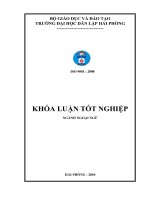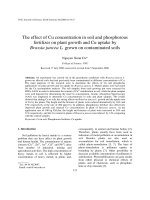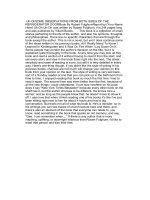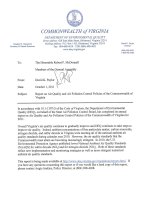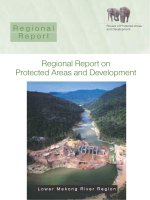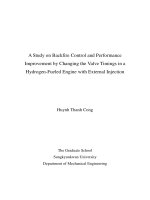the book report on the power and the glory by graham greene
Bạn đang xem bản rút gọn của tài liệu. Xem và tải ngay bản đầy đủ của tài liệu tại đây (33.83 KB, 3 trang )
The Power and the Glory by Graham GreeneBook report by Allen
RabinovichIt is the story-teller's task to elicit sympathy and a measure of
understanding for those who lie outside the boundaries of State Approval.
Graham GreeneOne day I gave The Power and the Glory to a native of
Mexico who had lived through the worst persecutions She confessed
that your descriptions were so vivid, your priest so real, that she found
herself praying for him at Mass. I understand how she felt. Last year, on a
trip through Mexico, I found myself peering into mud huts, through village
streets, and across impassible mountain ranges, half-believing that I
would glimpse a dim figure stumbling in the rain on his way to the border.
There is no greater tribute possible to your creation of this character - he
lives.An excerpt from the letter of Californian Catholic teacher to Graham
Greene, 1960 IIn a particular Mexican state the Church had been
outlawed and the priests had to go underground by the threat of being
shot. After several months from the governor's office appeared a news,
that there was still one priest, Father Montez, who was moving from
village to village working on the Church by administering the sacraments,
listening confessions and saying masses. A young lieutenant of police,
and ardent revolutionist and an anti-clerical, asked his chief to let him
search for the priest who, as the authorities understood it, was guilty of
treason. Two photographs were pasted up together in police station. One
was the picture of an American bank robber who killed several police
officers in Texas; the other was that of the priest. No one noticed the
irony, including the young lieutenant, who was more interested in
arresting the priest. When the officer received permission to look for
Father Montez, the priest was already in the village, where he came to
get aboard the boat that would take him in the city Vera Cruz and
safety.In the village he met Mr. Tench, old dentist who wanted somebody
to speak English with. But before Father Montez could get aboard the
boat news came to him that an Indian woman was dying several miles
inland. True to the call, the priest sat on the mule and went to administer
the last rites to the dying woman, even though he realized that he might
not find another ship to carry him to safety. There was one other priest in
the region, Father Jose. But Father Jose was so coward, that he
renounced the church up to the point of taking a wife, a shrewish old
woman. The authorities paid no attention to him at all, for they felt, and
rightly so, that the priest who had renounced his vows was a shame to
the Church.After completing his mission, Father Montez came back to the
coast, where he spent the night in a banana warehouse. The English
manager on the plantation allowed him to hide there.The following day,
hoping to find safety from the police and from the revolutionary party of
Red Shirts, he went further. As he traveled, he thought of his own past
and of himself as a poor example of the priesthood. He considered
himself a "whiskey priest", a cleric who would do almost anything for a
drink of spirits. Thinking himself a weak man and a poor priest, he was
still determined to carry on the work for the Church as long as he could,
not because he wanted to be a martyr, but because he knew nothing
else to do.After twelve hours of travel he reached the village where his
one-time mistress and his child lived. The woman took him for a night,
and the following morning he said a mass to the villagers. Before he
could escape the police entered the village. Marcia spoke with him as her
husband, and his child, a little girl of seven years old, named him as her
father. In that manner he escaped. Meanwhile the police decided to use
a new tactic in searching him. As they passed through each village the
took a hostage. When a certain time passed without the appearance of
father Montez, a hostage was shot. In that way the lieutenant of police
hoped to persuade the people to betray their priest.After the police had
left the village without discovering him, Father Montez took his mule and
went on his way. He traveled northward to escape the police and, if
possible, to make his way temporarily into another state.Some hours after
leaving the village, Father Montez met with a mestizo who joined him.
Before long the half-breed discovered that Father Montez was the priest
for whom the police were searching. He promised that he, a good
Catholic, would not betray the secret, but Father Montez was afraid that
the promised reward of seven hundred pesos would be too much for a
patience of the poor man.When they reached a town , however, it was
Father Montez own weakness which put him into the hands of the police.
He wanted to have some liquor, the selling of which was against the law.
He tried to buy some illegally, but his possession of the contraband was
discovered by one of the revolutionary Red Shirts, who raised a cry about
this. Tracked down by a police, the priest was caught and placed in the
prison. Fortunately, the police didn't recognize him, but since he had no
money he was kept in jail to work and thus to pay the fine.The lieutenant
of police who was searching for him unexpectedly did father Montez a
good thing. Seeing the old man working about the prison, the lieutenant
stopped to talk with him. The priest said he was a vagrant who had no
home of his own. The lieutenant, feeling sorry for the old fellow, released
him and gave him a present of five pesos. Leaving town, Father Montez
started out across the country to find a place of temporary safety. After
traveling for some time, he met an Indian woman who could speak only a
few words of Spanish. She wanted to make him understand that
something was wrong with her child. He went with her and found that the
baby had been shot; his immediate guess was that the American bandit
had done the deed.After making rites over the child, Father Montez
continued his flight. He went into the next state, where he was given
sanctuary by a German plantation owner. After resting a few days, he
planned to go to a city and there tell about his problems to his bishop.
Before he could leave, however, he was found by the mestizo, who said
that the American bandit, a Catholic, was dying and needed the priest.
Father Montez answered the call, even though he was sure he was being
led into trap. The bandit was really dying, but he was in the state from
which Father Montez had just escaped. With him was a party of police,
waiting for the priest's appearance in order to arrest him.Immediately after
the bandit's death the police took Father Montez . He was taken back to
the capital of the state and accused in treason. Then he was found guilty
and sentenced to be shot. The lieutenant of the police, who felt sorry in a
way for the old priest, tried to persuade the renegade Father Jose to hear
Father Montez' last confession, but Father Jose, who feared the
authorities, refused. Father Montez was led out and shot. But the
lieutenant of police had not succeeded in removing the Church's
influence; in the evening of the day on which father Montez died another
priest made his way, in secret, into the town where the execution had
taken place.II. The events of the book take place in one of the Mexican
states, somewhere in the Tabasco region. Historically the time of the plot
is 1930's. As the book shows, this historical period was very difficult for
the country, because it was the time of "great reforms", i. e. the time of
passage from the monarchism to communism. The beginning of this
reforms was the Mexican revolution, which took place in 1910. Also the
book tells a lot about the climate of Mexico. It is very hot and dry. The
landscape, like one on the cover, is very typical for Mexico.III.The Power
and The Glory, first published more than fifty years ago in a modest
English edition of 3,500 copies, is Graham Greene's masterpiece, his
most popular book. Based upon less than two months spent in Mexico in
March and April of 1938, the novel of Greene is his "least English",
containing only a few minor English characters. And when I read it I
completely agreed with the Catholic teacher (I found the excerpt of the
letter, which I placed as an epigraph in the beginning of my report, in
periodical literature before I finished reading the book) who wrote to
Graham Greene - "descriptions were so vivid, your priest is so real" - I felt
that characters were real. I've never been in Mexico, and I can't say were
these events and descriptions of them true or false, but I can say that
they are very realistic. The novel reflects the author's interest in Mexico
and his experience as a resident of that country. A Mexican priest in 1978
told to Greene's biographer, Norman Sherry: "As a Mexican I traveled in
those regions. The first three paragraphs, where he gives you camera
shots of the place, why it is astounding. You are in the place". Greene's
reality showed me the Mexico, than I've never seen before. But the most
interesting thing, from my point of view is that the story occurred many
times in many places before and after the appearance of the book. As an
example I can take the country, where I was born - Russian revolution in
1917 resulted the same persecution of priests and Church. Greene deals
masterfully with the mystery of the God, with people's beliefs. In The
Power and the Glory Greene illustrates God's kindness as it defies the
violent, atheistic government through the faith of his flawed, but still
faithful people. And as the communism begins to spread all over the
world, Greene's book assures the reader that there is a God, who will
never leave us, and the evil will never win him.
